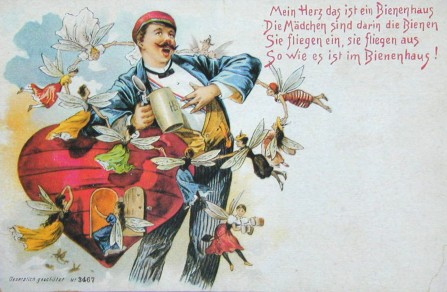
 Stein Collectors International
Stein Collectors International
Featured Stein: February 2004

 Stein Collectors International
Stein Collectors International
Featured Stein: February 2004
by George and Gabi Schamberger This article first appeared in Prosit in December 2003. Zeidl is the old, high-German name for honey, and a Zeidler was a person who cared for bees and collected honey in the forest. The Zeidler formed an organized beekeeper's guild as early as the 12th century, having their own court system with a Zeidlmeister acting as judge. In 1350 King Karl I of Bohemia granted special rights for the Zeidler. This decree allowed the Zeidler to collect honey in the forest area around Nürnberg, but they were also required to return a quantity of honey to the crown each year. This Zeidler-Privileg is preserved today in the Public Record Office in Munich. The guild of the forest beekeepers, honey collectors and wax suppliers was respected and they enjoyed special privileges. Members were allowed to wear their own costumes (Tracht) and carry a cross-bow. They had the honor to act as bodyguards when royal visitors were in town. They could also take wood from the forest for either construction or their fires, free of charge. Their products were tax-free, and more importantly, the estates they owned were not subject to taxes. In the wooded area around Nürnberg were approximately 50 Zeidler estates, areas with nectar-rich firs, pines, hazelnut bushes, willows, different berries and especially the little red Erika flower (red heather). Millions and millions of busy bees produced their honey in these woods, and as early as 1296 the area was known as "the Emperor's Bee Garden." When a Zeidler found a swarm of bees in a tree, he would clear the branches and put his Hausmarke (seal) on the tree, thereby claiming it for himself. If another Zeidler laid his hands on a swarm in a marked tree he was called in front of the Zeidler court and was severely punished. On the other hand, if a Zeidler could not retrieve a lost swarm, it belonged to the finder. This tradition of "finders-keepers" continues today. In these early days honey was the only sweetener for drinks or sweets. The customers were the Lebküchner (gingerbread makers) and other bakers, as well as royalty, nobles and aristocrats. Honey provided nourishment and was said to have healing power. There was also great demand for the sweet smelling beeswax. Countless candles were needed for churches, emperor's houses and the houses of the aristocrats. In 1427 the large area of the "Emperor's Bee Garden" was sold to the city of Nürnberg and the Zeidler's privileges were accepted by the city council. The last meeting of the Zeidler court was held in 1779 in the "water castle" (Cartäuser Weiher). The guild mark of the Zeidler-Schütze carved in stone is still visible above the main entrance of the castle. The character stein illustrated with this article was produced by Reinhold Merkelbach to celebrate the Zeidler. A heart-shaped panel on either side contains two short verses from what is said to have been a popular song among German soldiers at the turn of the century.
A postcard from the same era shows a young man in the dress of his student fraternity captivated by the same bees - now shown in human form - as they buzz around him. . 
|